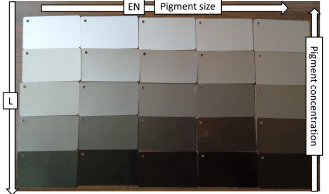
E-commerce has become the primary global shopping method, but the inability to physically inspect products presents challenges for consumers. This study focuses on the sparkle texture effect, significant in various industries. Evaluation tools are limited to two instruments, leading the International Commission on Illumination (CIE) to work on establishing measurement scales. The study proposes a rendering model sparkle utilising a metrologic scale based on the luminous point density and visibility probability distribution, by assuming a half-Gaussian shape which should be fitted to measurement data in order to obtain parameters μ and σ. The model algorithm was computed for 25 samples across three different geometries (15º:0º, 45º:0º and 75º:0º). The maximum deviation between measurements and the fitted function was found to be 0.09, indicating negligible discrepancies in terms of cumulative probability. The analysis revealed that μ tends to approach zero for all samples, while σ showed a correlation with the density of sparkle points dS, with a Pearson correlation coefficient exceeding 0.91 for all geometries, indicating a strong relationship between the two variables. A preliminary rendering is obtained, using Mobile Display Characterisation and Illumination Model (MDCIM) for the background colour.
Aurora Larrosa, Julián Espinosa, Alejandro Ferrero, Nina Basic, Néstor Tejedor, Esther Perales, "A Sparkle-rendering Model Based on Metrological Parameters" in London Imaging Meeting, 2024, pp 120 - 123, https://doi.org/10.2352/lim.2024.5.1.25
 Find this author on Google Scholar
Find this author on Google Scholar Find this author on PubMed
Find this author on PubMed